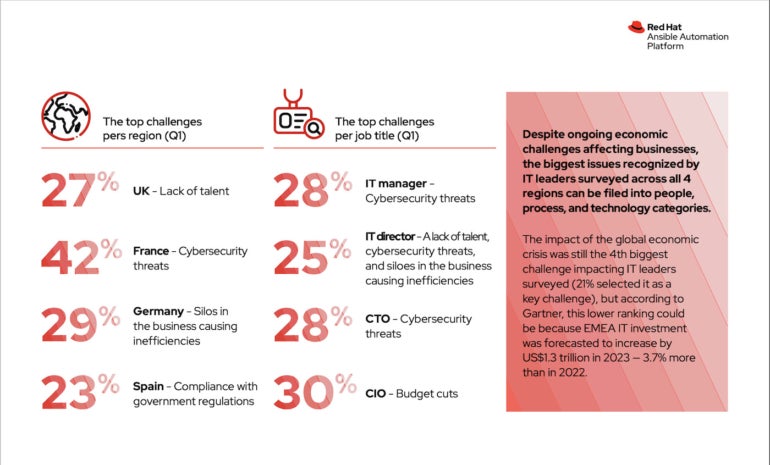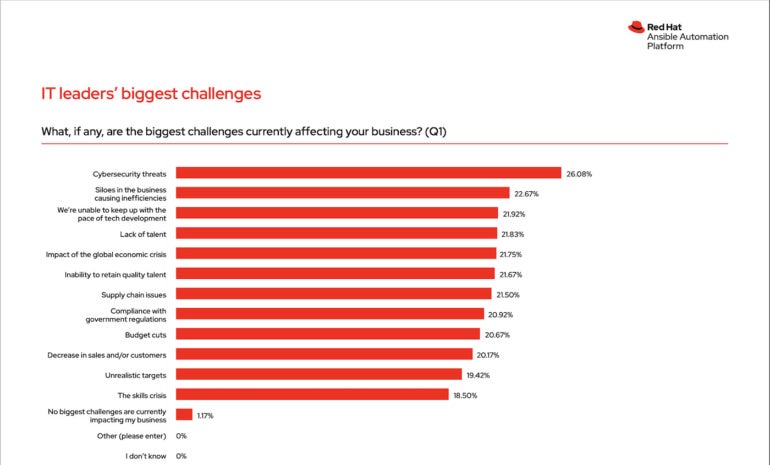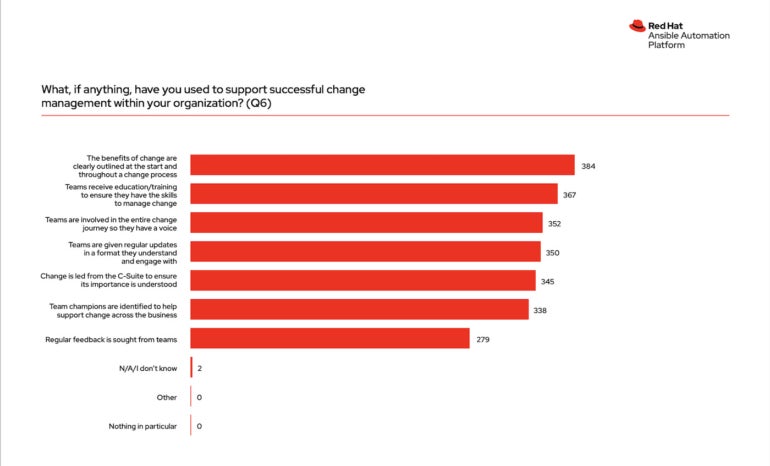
The U.K.’s position as a financial services hub puts it ahead in enterprise-wide IT automation, says Red Hat. But skills shortages remain an issue for all IT leaders surveyed.
More than a quarter of U.K. businesses have automated IT processes across the organization, according to a new survey from Red Had — putting them ahead of their European counterparts in Germany (18%), Spain (16%) and France (12%).
Red Hat’s report, Thriving through change with enterprise-wide IT automation, surveyed 1,200 IT leaders in the aforementioned four countries about the role of automation in their businesses and the challenges they faced in adopting new technologies.
It found that 27% of U.K. companies have achieved “enterprise-wide automation,” defined by Red Hat as automation of the most valuable IT processes such as network configurations, firewall rules, security policies and cloud orchestration. This was compared to only 18% of IT leaders — including IT managers, IT directors, CTOs and CIOs — across all regions who had achieved the same.
Jump to:
Richard Henshall, director of product management for Red Hat’s automation platform Ansible, credited the U.K.’s position as “a global hub for financial services” for its progress in achieving enterprise-wide automation, which he said had fostered a “unique blend of innovation, efficiency and diverse global influence,” in the U.K. IT industry.
“These factors have catalyzed the adoption of advanced technologies such as automation, leading to rapid deployment of high-speed manufacturing processes and integration of Fourth Industrial Revolution technologies across the U.K.,” Henshall told TechRepublic via email.
He added, “This strategic adoption has emphasized workforce development as businesses increasingly recognise the economic benefits and productivity enhancements, from upskilling or retraining employees for the digital era.”
According to Red Hat, most U.K. companies have an automation strategy and are working towards it. Twenty-nine percent said they were on the path to enterprise-wide automation, while 25% have an automation strategy but haven’t yet started automating tasks. Just 4% of U.K. survey respondents said they haven’t automated any processes and don’t plan to.
Other U.K.-specific findings by Red Hat include:
SEE: Isambard-AI: UK’s New £225m AI Supercomputer to Be Among the World’s Fastest (TechRepublic)
The report noted that enterprise-wide automation can look different according to the individual organization and its priorities, and “does not necessarily mean all processes are automated” — only the most valuable.
While all survey respondents recognized the benefits of automation (Figure A), such as a better customer experience (33%), higher revenue/sales (30%) and more productive teams (28%), a quarter of respondents said they don’t have an automation strategy in place.
Of the 82% of respondents who said they haven’t achieved enterprise-wide IT automation, common barriers include not having the skills to implement automation (29%), limitations in the organization’s tech stack (28%), and concerns about the cybersecurity implications of automation (28%).
Figure A
SEE: Software Automation Policy Guidelines (TechRepublic Premium)
For IT leaders in the U.K., a lack of talent was cited as the biggest challenge for their business, reported by 27% of U.K. respondents.
In the other regions, the top challenges reported by the IT leaders (Figure B) in those countries are:
Figure B

Across all IT leaders in the U.K., France, Germany and Spain, the biggest challenges facing businesses are cybersecurity threats (26%), inefficiencies caused by departmental IT siloes (23%) and keeping up with the pace of technical development (22%), according to Red Hat’s survey (Figure C.)
A lack of talent (22%) and an inability to retain quality talent (22%) were ranked as the fourth and sixth biggest challenges cited by IT leaders, respectively.
Henshall said: “The big challenge we see affecting organizations at the moment is the skills shortage. There is a lack of the knowledge businesses need to grow in a period of rapid tech evolution. At our 2023 Red Hat Summit, ‘people’ were the basis of 95% of the conversations taking place: Where do I find the right people? How do I upskill them within my organization? And how do I motivate wider teams to embrace change?”
Figure C

The top challenges cited by respondents also varied according to their role within the organization. These include:
Red Hat’s report indicated that IT leaders feel employees are hesitant to adapt with the times, even as businesses are facing skills shortages.
When quizzed on their teams’ openness to adopting new technologies or processes, 92% of IT managers suggested employees are reluctant to change. Driving factors for this perceived reluctance include a lack of time to implement automation (45%), feeling overwhelmed by overly complex or technical changes (40%), and the idea that teams “would rather do their own thing and don’t want to be told what processes or technology to use” (39%).
When asked about best practices for effective change management (Figure D), IT leaders cited the need to clearly outline the benefits of change throughout a change process (32%), giving teams relevant education and skills training (31%) and involving teams in the entire change journey (29%).
Figure D

SEE: 5 Best Change Management Software of 2023 (TechRepublic)
“Automation should be a collaborative and agile movement; people need to be enabled and motivated from the start and continuously engaged,” Henshall said in a press release. “And when you enable people to use AI, big data and the cloud in a meaningful way, their sense of purpose and pride increases — it fuels a virtuous cycle.”